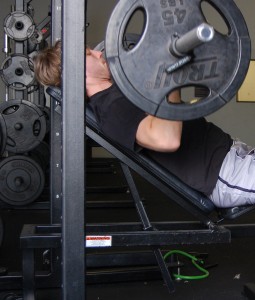By: Steve Yahns, MS, CSCS, NASM-PESAssistant Director of Performance, Lead Methodology EducatorSpectrum Sports Performance
Let’s face it, just about all football players love to Bench Press and love to discuss their Bench Press numbers. They talk about either their 1 rep max, how many times they can put up ‘two plates’ or 225. Scouts place a relatively high importance on this test because it gives them an accurate measure of strength and endurance. “At the Combine, they correlate the strength from the endurance,” says Andy Barnett, who trains players prior to the Combine at Athletes’ Performance in Gulf Breeze, Florida. “So if you do more reps, your one-rep max [the most weight you can lift once] is stronger. It takes less time than trying to find someone’s one-rep max.” Being one of the most popular and widely performed lifts, there are several considerations athletes must take into account when training to improve their 225 Bench test.
When Pressing, don’t JUST Bench Press
Once again, one might think since the test is 225, as many reps as you can, one should train with 225 during every training session. Muscle endurance is obviously going to be important when trying to get extra reps, but overall strength and maximum strength can help get a few extra reps, not to mention make 225 feel lighter than it may have used to. It goes without saying that when we increase weight, we will decrease reps. This is fine, as long as we do it in a progressive manner (dropping reps and adding weight every session or every week). Amidst working with different loads, we should still have the athlete rep out with 225 once a week or so, so that they are working at the actual test weight.
Don’t forget your Upper Pulls and Lower Lifts
Working on our Upper Pulls not only helps us maintain good posture, but helps keep the upper body “balanced,” and helps reduce the risk of injury. “Balance” in the body refers to the same muscle length for opposing muscle groups or sections of the body. When pressing, the pulling muscles are the antagonists (they work against the pressing muscles). Proper range of motion when pressing is important for strength and power production, and we get this through “balance.” To get this balance, we need to strengthen our pulling muscles and elongate, or stretch, our pressing muscles. Balance is also important for reducing the risk of injuries. Nothing will shut down your benching plans faster than a shoulder or elbow injury. Balance can also refer to the upper and lower halves. If we neglect our lower half, we limit our overall strength. The bench press may seem like an upper only lift, but the push we can get from our legs into the ground and the strength of our Glutes and core musculature can dramatically help our rep test. Treat your body as a whole unit while benching. The lower half, torso, and upper half all are designed to work together.
Work on your grip
Believe it or not, improving your grip strength can directly help your bench test. It’s pretty simple, the harder you squeeze the bar when you bench press, the more muscles you can recruit, which results in a stronger bench press performance. Grip strength training can include simple grip exercises or forearm strengthening. It’s a little thing to focus on and can pay dividends.
As with the previous blog, training for these tests should all be an integrated approach. There never is one simple strategy to decreasing time, improving height and distance, or bench press reps. WORK SMARTER, AND THEN WORK HARDER!!!!

Leave a Reply